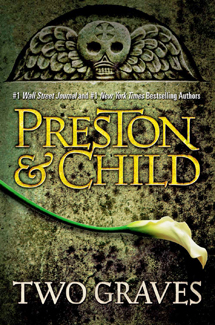Wrapping up the unofficial “Helen Trilogy” that started with “Fever Dream” and “Cold Vengeance,” Douglas Preston and Lincoln Child reveal new surprises and wrap up the long-gestating mysteries of Helen Pendergast and Constance Greene in “Two Graves” (December, hardcover). Like the 11 previous books chronicling retired-but-still-active FBI agent Aloysius Pendergast, it’s a page-turner, although in the long run it won’t rank among the most memorable entries.
I had thought that perhaps Preston and Child’s new Gideon Crew series would be their outlet for completely over-the-top “24”-style action, where the hero gets beaten up to an insane degree but keeps bouncing back. The opening segment, where Pendergast pursues his wife Helen’s kidnappers across most of North America in the span of a couple days, puts a lie to that notion. I was literally giggling out loud at some of the absurdities. To be nitpicky, there are some sloppy moments — the authors work hard to make Pendergast’s quick movement across the Southeast plausible, but then he’s suddenly in Mexico without much explanation about how he got there.
With Pendergast wrapped up in his personal vendetta, NYPD Detective D’Agosta pursues a fascinating mystery where the serial killer expertly disguises himself and somehow knows exactly when to depart the crime scene. He’s clearly toying with the detectives though, as he commits every murder in the same fashion and seems to leave pieces of his own body as part of the grisly tableau.
Two other compelling side plots are more like short stories within the larger story: Dr. Felder searches for proof that Constance is indeed 140 years old despite appearing to be about 30, and Corrie Swanson — Pendergast’s young assistant introduced back in “Still Life With Crows” — investigates her first case: Her estranged dad being framed for a bank robbery.
I found the final act of “Two Graves” — which moves to the jungles of Brazil without really doing justice to the setting the way these authors usually do — to be a bit of a slog, as it’s heavy on action, explosions and violence. Ultimately, D’Agosta, Constance and Corrie get short shrift in this novel. Corrie’s chapters were some of my favorites in the middle of the book, but then the focus moves entirely to Pendergast. The authors go a long way toward making up for this in the final pages, though, as it’s strongly suggested that we’ll get more of Corrie in future books. And while the big Constance mystery is resolved, we’re certainly not done with her either.
The “Helen Trilogy,” although an outstanding read, ranks as one of the craziest entries in the Pendergast series, as the authors clearly didn’t put any limits on their imaginations. Next, it might be nice to tone things down with a less world-hopping, more intimate, evocative mystery in the vein of the book that started it all, “Relic”; perhaps Corrie Swanson could take center stage with Pendergast — who I imagine being completely exhausted after the events of “Two Graves” — serving as an adviser from the bowels of his now-legendary Riverside Drive mansion.


